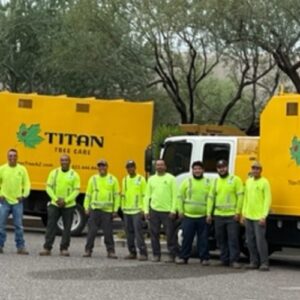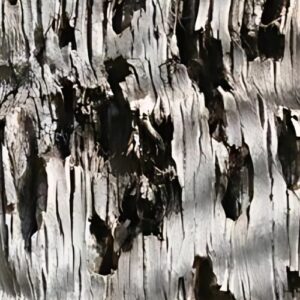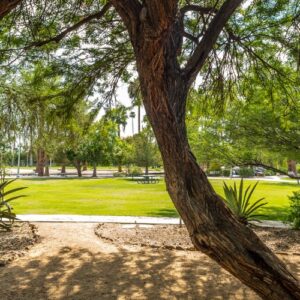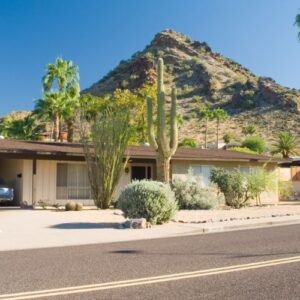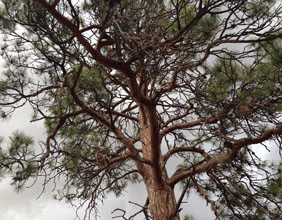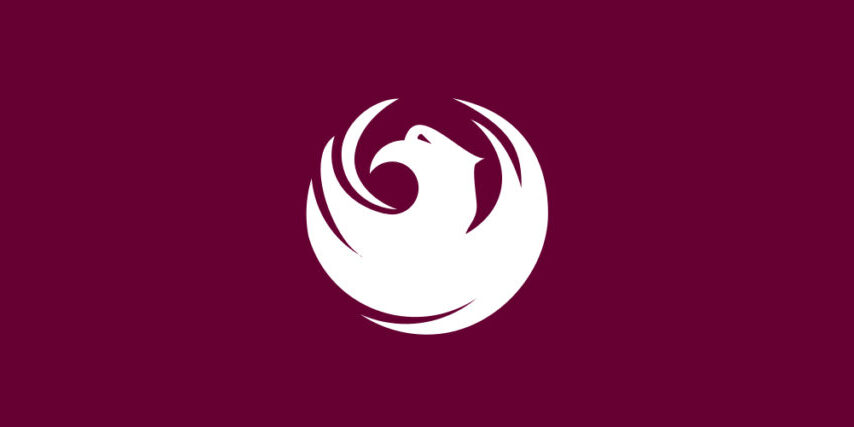
In 2010, Arizona State University and the City of Phoenix adopted a plan to create an urban forest in the city.
The goal of the Tree and Shade Master Plan is to have a 25% tree canopy in Phoenix by 2030. As the city currently has an average tree coverage of only 9-11%, this is a plan that will need considerable support and help from Phoenix area residents and visitors to make possible.
We highly recommend reading through the entire plan yourself, but below are the highlights of the Vision. By 2030:
- Phoenix has a healthy, diverse and sustainable urban forest that reflects and preserves the beauty of the Sonoran Desert.
- Shade trees line streets and residential neighborhoods are cooled by tree groves.
- The urban forest lowers the temperature during summer months, reducing energy use and making the city more comfortable for residents and visitors.
- Citizens understand the benefits of the urban forest and view it as a critical component of the infrastructure that must have regular investment and maintenance.
- The urban forest contributes to the economic, environmental and social wellbeing of our city.
Given how ambitious the project is, why would the city put its resources into planting trees?
Because trees have many benefits that improve residents’ quality of life and ensure that Phoenix and surrounding cities remain a top destination for visitors, businesses and new residents.
Trees are a Great Return on Investment
Here at Titan Tree Care, we work with trees because we love them. We know not only that they provide much needed shade and cooling, but that they are proven stress relievers, air filters, and a habitat for wildlife.
Trees also prevent rainwater runoff and soil erosion, reduce energy costs, lessen the severity of storms (yes, really!), help us all to breathe better, are a natural property border and noise blocker, and provide us with beauty and a sense of pride in our neighborhoods.
In areas with more tree cover, crime is reduced, shoppers spend an average of 9 to 12% more money, people are more active, and property values are higher.
So with all of these benefits that have been proven by multiple studies, you can see why adding more native trees to the Phoenix area is a priority.
Phoenix: City of Trees?
Did you know that at the end of the 1800’s and early 1900’s, Phoenix used to be known as the city of trees? Seriously. You can see pictures of it here.
Check out this quote from a visitor to Phoenix in 1905:
“Everywhere there is shade and plenty of it. The entire valley, from Mesa into Phoenix, is one solid mass of green … and the entire distance from Mesa to Phoenix can be driven under an almost unbroken arch of shade.”
Quote taken from the Tree and Shade Master Plan
Unfortunately, most of the trees were later removed because the trees they planted at that time were not suitable for the desert landscape and used too much water. Other trees were cut down to make way for new construction and, because with the advent of air conditioning, people thought that shade was no longer needed.
Temperatures have risen significantly in Phoenix in just the last few decades due to loss of trees (and the shade they provide). Plus, the significantly increased use of asphalt and concrete traps daytime heat and releases it during the night, leading to an increase in nighttime temperatures.
Other Cities and Organizations Have Adopted Tree Planting Resolutions
Phoenix is not the only major city with a goal of more trees. New York City’s plan for a sustainable city included planting and maintaining one million trees. They reached that goal and celebrated the planting of the one millionth tree on November 20, 2016 – two years ahead of schedule!
Los Angeles, Chicago, Houston, Denver, London, and Shanghai have announced similar million-tree initiatives. Most recently, the Arbor Day Foundation launched their plan to plant one HUNDRED million trees by 2022, with a dedicated website for the plan, called “Time for Trees.”
Where Will the Water for These Trees Come From?
The Tree and Shade Master Plan calls for planting native trees throughout the Phoenix area as a way to minimize the amount of water required to support the tree canopy goal.
Native trees, such as palo verde or desert willow, don’t need any supplemental water once they are established. Beyond the first year or so after being planted, you don’t need to water them at all; the water from rainfall is sufficient. Native trees know how to survive in desert environments and, in many cases, providing them with extra water does more harm than good.
However, the use of water can always be improved. By using drought-tolerant plant material in your landscape (in addition to native trees), installing high-efficiency irrigation systems, and using smart watering practices, we can minimize water use while still creating inviting green spaces.
If you’re interested in learning more about water efficient irrigation systems, be sure to contact us today.
A Difficult, but Not Impossible, Goal
While the tree canopy in metro Phoenix was estimated to be 12.4% in July 2015, many trees have been lost since then to monsoon damage, accidents, disease, new building developments, etc. Due to an underfunded city budget, most have not been replaced. Overall, more trees are being removed than replaced, leading to a smaller percentage of tree canopy cover over time.
Some areas of the city have a higher percentage of tree cover, while others (usually lower income areas) have a much lower percentage. With temperatures rising, along with the number of heat-related deaths, the shade that trees provide is much needed.
What You Can Do
1) Plant trees! Plant them on your property, volunteer to help plant them in neighborhood parks, find organizations that will teach you how to properly plant trees and will give you opportunities to give back.
Here are some good tree-planting and volunteer organizations to get involved with:
- Keep Phx Beautiful
- Trees Matter
- Arbor Day Foundation
- Arizona Community Tree Council
- Citizen Forester Program
2) Take care of the trees you do have.. The loss of trees and their heat-reducing properties is one of the main reasons that the temperatures keep rising in the Phoenix area. Ensuring that you have healthy, mature trees can do a lot to counteract the heat. Preventive pruning, pest control, and inspections can do a lot to increase the longevity of a tree, and the benefits multiply the older a tree becomes.
3) Learn more about the benefits of native trees so that you can educate those around you. As a metro area that is home to a lot of transplants, knowing which trees survive and thrive in a desert environment is an important thing to learn. Just because a tree grew well elsewhere does not mean that you should plant one in your Phoenix-area backyard. That’s one of the many reasons that Anthem has an approved plant and tree list.
4) Set an example. There’s no reason that Anthem or other Phoenix suburbs can’t lead the way in tree planting initiatives. Once other parts of Phoenix see how beautiful and inviting a tree-covered area can be, they’ll want to plant trees too.
“The best time to plant a tree is 25 years ago. The second-best time is now.”
Chinese proverb
More Articles Like This

Titan Tree Care is a full-service tree care company located in Anthem, AZ and serving all of North Phoenix. We offer a wide range of services to meet your tree care needs, including tree and palm trimming, tree pruning, tree removal, stump grinding, and more. We also offer insect or disease treatments and fertilization services. We are dedicated to providing high-quality, safe, and effective tree care services to our customers and work hard to ensure that your trees are healthy and look their best.





